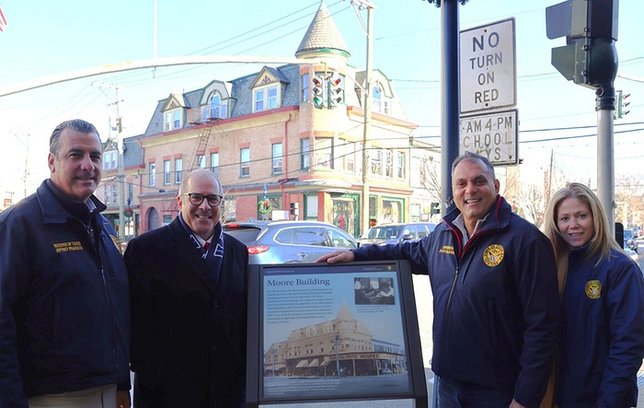Oyster Bay Town Supervisor Joseph Saladino and the Town Board, in collaboration with Sagamore Hill National Historic Site, continue to bring history alive in Oyster Bay hamlet, now with the installation of 30 historic interpretive panels highlighting President Theodore Roosevelt’s deep connection to the community and its landmarks. Funded by the National Park Service, the project helps preserve American history while attracting tourism and economic activity to the area.
Supervisor Saladino stated, “This collaboration between the Town and Sagamore Hill National Historic Site transforms downtown Oyster Bay into a dynamic hub of historical significance, inviting families, students, and history enthusiasts to explore the legacy of Theodore Roosevelt without leaving Long Island.”
“We encourage all visitors to Sagamore Hill to explore Oyster Bay to better understand the places that shaped Theodore Roosevelt and the Roosevelt family,” said Superintendent Jonathan Parker of Sagamore Hill National Historic Site. “These historic panels, through an outstanding partnership with the Town, reveal the significance and meaning of these important historical locations for local residents and visitors alike.”
While 21 historical panels are located at Sagamore Hill, nine are in downtown Oyster Bay. Oyster Bay is one of the few towns in the United States of America with National Park Service interpretive panels installed outside of the federal boundary of the local national park. Historic panels, educating visitors on the compelling stories of Theodore Roosevelt, include:
- Moore Building: Presidential offices with telegraph lines to the White House, War Department and other agencies.
- Oyster Bay Train Depot: the starting point for Governor Roosevelt’s travels to Albany. Upon his return trips to Oyster Bay, he was often greeted by crowds of well-wishers.
- Derby-Hall Bandstand: Roosevelt was known for delivering speeches from this site.
- Snouder’s Corner Drug Store: a gathering spot for the press corps covering the activities of Oyster Bay’s most famous resident.
- Fisher Building: voting site of Roosevelt on November 5, 1901, after arriving by train and taking a carriage to the polling place.
- Christ Church: local parish for the Roosevelt family and funeral site for the President.
- Youngs Cemetery: burial site of the 26th President of the United States of America.
- Audubon Sanctuary: the nation’s first Audubon Sanctuary, the site reminds us that Roosevelt preserved over 85,000 acres of land in the United States for parks.
- Oyster Bay Bank: Gubernatorial office for Roosevelt, and site of the original Presidential telegraph office (installation in Spring 2025).
Helping to bring history alive, plans are underway to include digital and traditional tourism guides to complement these historical panels. Additional initiatives by the Town, such as annual historic reenactments and the dedication of a section of Audrey Avenue as Theodore Roosevelt Way, are further enriching this historical vision significance of Oyster Bay hamlet.
Credit: Town of Oyster Bay










